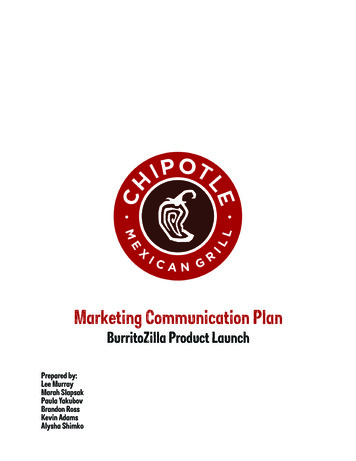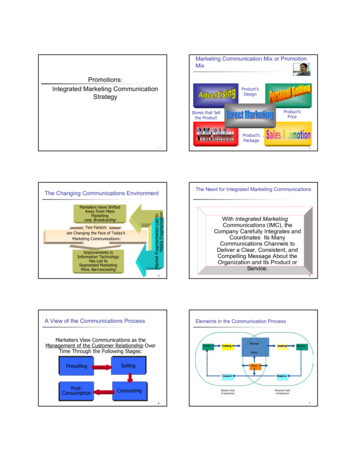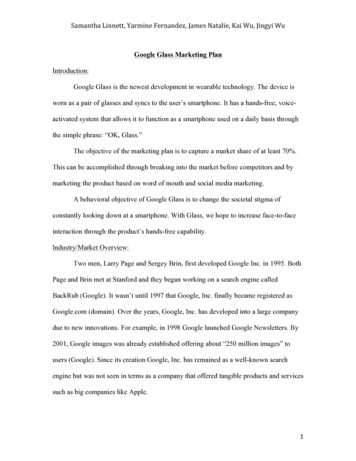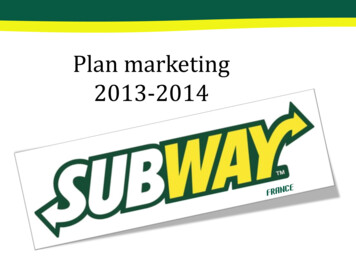
Transcription
Marketing Communication PlanBurritoZilla Product LaunchPrepared by:Lee MurrayMarah SlapsakPaula YakubovBrandon RossKevin AdamsAlysha Shimko
Client OverviewThe RestaurantChipotle Mexican Grill (NYSE: CMG)is a public company based in Denver,Colorado.Chipotle specializes in tacos, burritos,and salads. Chipotle positions itself asan ethical business that uses locallysourced organic ingredients and is theleading restaurant chain in the “FastCasual” niche.100 percent of chicken and porkserved is naturally and humanelyraised.The ExperienceFinancial OverviewInternational Locations“Fast Casual” refers to a finedining experience served witha fast food speed. Chipotledominates this sector of themarket and boasts dedicatedfront line staff, middlemanagement, and executives.Chipotle owns two otherrestaurant chains. “ShophouseSoutheast Asian Kitchen” and“Pizzeria Locale” offer differentexperiences within the “FastCasual” niche and thoseadditional outlets allow Chipotleto diversify its menu options.Financial overviewChipotle owns a total of 1595locations, opening 185 newrestaurants in 2013. Annualrevenue for that year 3.21billion, a 17.7percent growth overprevious year, and the chainenjoys the best operating marginin the industry: 26.6 percent.International locationsChipotle has restaurants inseveral countries, and althoughexpansion in the Europeanmarket is slow because oflow brand awareness, growthis steady. Chipotle plans toopen a further 180 restaurantsthroughout 2014.CountryNumber of locationsUnited States 1572Canada7England6France2Germany1
Mission Statement“Food With Integrity: It means serving thevery best sustainably raised food possiblewith an eye to great taste, great nutrition andgreat value. It means that we support andsustain family farmers who respect the landand the animals in their care. It means thatwhenever possible we use meat from animalsraised without the use of antibiotics or addedhormones. And it means that we source organicand local produce when practical. And that weuse dairy from cows raised without the use ofsynthetic hormones. Food With Integrity is ajourney that started more than a decade agoand one that will never end.”
SWOT AnalysisSTRENGTHSWEAKNESSESOperating margin of 26.6% best in theindustry (2013)Fluctuations in the cost of premiumingredients and inflexibility of pricingstructure (2013)Only restaurant chain with commitment to non GMO ingredients (2013)Fine-dining experience with fast foodspeed of serviceOnly major Mexican food player in“Fast Casual” nicheDedicated front line staff, middlemanagement, and executives (2013)(Indeed)Heavily reliant on small list ofsuppliersSlow international growth due to lowbrand awareness (Shaw)High cost of quality ingredientsaround 33% of revenue (Shaw)Strong brand continues to dominatethe “Fast Casual” nicheHistory of backtracking on“responsibly raised” food standards tokeep up with demand could damagereputation (Choi)OPPORTUNITIESTHREATSCurrently diversifying menu optionsthrough secondary outlets “Shophouse Southeast Asian Kitchen” and“Pizzeria Locale” (2013)Limited supplier list increases risk ofsupply chain problems from naturaldisasters (2013)Seasonal fluctuations in sales leavesspace for further diversification duringwinter monthsUntapped franchising opportunities.Although Chipotle remains resistantto franchising, as the niche matures itcould become a viable option to maintain revenue (Taylor)Additional menu optionsFurther acquisitions of similar nicherestaurant chains (Cramer)Direct competitors selling higherquality food comparable to Chipotle(Gara)Customer profiles show that dinerswho enjoy the “Fast Casual” experience are fickle and often seek outinteresting alternatives (Baertlein)“Fast Casual” niche becoming saturated with Chipotle clones and othercuisines offering similar dining experience (Baertlein)
Competitor AnalysisChipotle has three maincompetitors in the QuickServe Mexican category. HotHeads, which was foundedin October of 2006, providesan atmosphere that appealsto “cool” customers with“awesome” food (Hot Heads)which is a similar conceptto Chipotle. As of 2014,Hot Heads currently has 58locations open. The strengthsof Hot Heads is their widearray of menu options. Theyoffer certain extras that arenot available at Chipotle,such as queso, and theirfood is available in moreforms. Another strength is themultitude of sauces that HotHeads carries. Hot Heads doesnot have very much brandpower. It is generally basedout of Ohio and the companyonly has 58 locations. Thefood served in Hot Heads isnot considered to be organicnor is their meat free-range, abig negative to those that arehealth conscious.Qdoba is the second maincompetitor of Chipotle.Qdoba was started in 1995and began franchising theirrestaurants in 1997. Qdobawas bought out by Jack in theBox in 2003 and continuesto grow as a company, withover 1,000 locations in theU.S. and in Canada. Qdobahas consistently been on theFranchise 500 list since 2010.(Entrepreneur). Similar toHot Heads, the strength ofQdoba over Chipotle is thattheir food is offered in moreforms - nachos, quesadillas,etc. Their target market isslightly different. Chipotle isgeared more towards middleclass people since it is on theexpensive side, but Qdoba iseven more expensive. Qdobaalso does not feature organicfood.The final main competitor ofChipotle in the Quick ServeMexican category is TacoBell. Taco Bell was foundedin 1954 and by 1967 hadalready opened 100 locations.Currently, Taco Bell servesover two billion people per yearand has over 6,500 locationsopened mostly in the UnitedStates (Taco Bell). Taco Bellis very well established, andhas many more locationsthan Chipotle (Hot Headsand Qdoba, also). Taco Bellalso features a drive through,a feature that does not fitwith Chipotle’s “Fast Casual”experience. Although a muchlower grade of ingredients areused in Taco Bell’s products,some of their menu itemsare lower in fat than those onChipotle’s (Business Insider).Taco Bell also has someweaknesses, including the badreputation that the companyhas garnered over the yearsabout the questionable contentof their meat. Although they areboth fast ways to get Mexicanfood, Taco Bell is consideredmore of a fast food restaurantthan Chipotle. Finally, like bothHot Heads and Qdoba, TacoBell does not feature organicingredients on its menu.
Target MarketChipotle targets several market segments:Young AdultsChipotle targets youngadults by openinglocations near collegecampuses and usingmarketing techniquessuch as handing outgift cards at collegeblood drives.VegetariansChipotleintroduced amenu item madefrom tofu.Parents withyoung childrenThey offer a kidsmenu to appeal toparents.Health-consciousadultsBy featuring organic,non-GMO food andfree-range meat, thecompany has a targetaudience of the healthconscious adults withdiscretionary income.
Brand PositioningFood with integrityFood with integrity is key to the Chipotlebrand. The company’s strength in the UShas been positioning the brand by offeringthe unique concept of integrity in the fastfood dining market. Chipotle is perceived tobe healthier than its competitors. Chipotlehas successfully positioned itself as aconsistently high-quality, quick serviceMexican restaurant. The quick serviceand high-quality Mexican food create anexperience for the customers which helpkeep them attracted to Chipotle. Chipotle’slogo—a dried up pepper—is well recognizedamong people, as is their top product: thefoil wrapped burrito. With a surveyed thatwas conducted, 79% of those who looked ata foil wrapped burrito associated that burritoas a Chipotle burrito.Unique Selling PointChipotle has created a unique selling pointamong its competition. Chipotle offerslimited variety but high quality food. Withthe limited variety, Chipotle ensures theyserve food with premium quality ingredients.“Food with Integrity” is marketed byChipotle as “commitment to finding the bestingredients with respect for the animals,the farmers, and the environment.” Eachof these food items have multiple variationsalong with different kinds of salsa, differentkinds of meats, and different kinds ofvegetables. Unlike Chipotle’s competition,customers are given the freedom tocreate and customize their meals with nolimitations. This personalization reinforcesChipotle’s dedication to putting theircustomers’ needs and wants first.
Marketing Communication Objectives & StrategiesObjectivesIncrease foot traffic through wintermonths. Chipotle’s turnover iscyclical, with higher revenues inthe summer months than the wintermonths. This promotion is in directresponse to that winter lull, and aimsto create more sales during the firstfew months of 2015.Expand upon key message and winmore business.Chipotle is a brand for healthconscious young people withdiscretionary income. The purposeof this promotion is to cast the netwider to engage with customers inthat market segment that have nevervisited a Chipotle before, and expandthe customer base.Reinforce the quirky natureof the Chipotle brand throughunconventional ads.StrategiesBENEFITSDRAWBACKSTelevision advertisingA national campaign willreach current customers andprospective customers alike.Long enough time slot toallow for narrative messageto be delivered.Expensive.Viewers not always engagedduring commercials.Many viewers not withinmarket segment.Personal sellingFront line employees havedirect contact with customersalready committed topurchase.Public RelationsCheap.Credible third-partyendorsement.Internet & social mediaCheap.Direct marketing to currentcustomers who are engagedand invite promotional offers.Word-of-mouth spread ofmessage more crediblethan traditional advertising(apparent endorsement ofthe message by users whoshare.)Not a tested method inChipotle.Fast-food tactic may not gelwith overall “fast-casual”experience.No guarantee of exposure.Opens campaign up toimmediate criticism.No guarantee of word-ofmouth/viral spreadPromotion eventsIn-store promotions and cross Lowers bottom line whencoupons are used.promotionsNot a tested method inChipotle.Disrupts the transaction andslows the line.
Creative Strategies & RationalesThe tv commercial will appeal to the target audience that ranges from teenagersto adults in their mid forties, because it focuses on the introduction of a biggerburrito presented in the form of BurritoZilla, which is a reference to Godzilla.Chipotle is a company that likes to cater to the hip, urbanite crowd.Television Advertisement:The tv commercial will start with a woman who orders the new BurritoZillafrom the secret menu. The employee (woman) behind the counter flinches andducks behind the counter slightly because she knows what will happen next.BurritoZilla crashes through Chipotle and the only thing the viewer can see isBurritoZilla’s tinfoil wrapped foot and hand as he hands her the customer theburrito. The walls crumble to the floor as BurritoZilla roars and stomps away,shaking the ground. As the viewer watches BurritoZilla stomp away from thestore, a man with a deep voice says “BurritoZilla, it’s double wrapped withdouble meat; double trouble”. After that, the employee rises from behind thecounter, dusts herself off, and another customer (male) says he wants to try aBurritoZilla and the employee gives him a dirty look.Setting:The Chipotle will be a stand-alone establishment placed within a suburban city.The inside will be larger and made up with about 20 tables inside, a cutlery andsauce station, and the main counter.Lighting:The scene will take place during mid-day which will provide maximum lightquality combined with the lights inside the establishment. The commercial itselfwill be bright-colored with clean picture quality.Audio:The conversation between the customer and the employee will be the mainfocus at first, then the sounds of BurritoZilla crashing through the building willtake over until BurritoZilla leaves and the sounds of his stomping fade and thenthe announcers voice will be the focus. Before the commercial ends, the viewerwill hear the pieces of the walls crumbling and the second customer saying hewants to order a BurritoZilla as well.Camera Angles:First, the camera will show both women communicating, then it will pan over tofocus strictly on the employee behind the counter. Next, it will be set behind thecustomer, facing the counter and BurritoZilla’s foot will come into view from theright-hand side. After, the camera will pan over to watch BurritoZilla stomp awayand will focus there until the announcer’s voice is silent. After that, the camerawill show the employee rising from the floor behind the counter and brushing offthe dust and debris from the building. Finally, the camera will pan back over toshow both women and the male customer standing by the counter.
Media Strategies & RationaleThe BurritoZilla campaign will focus on twomediums: Television and social media.TelevisionThe commercial takes place at a Chipotlerestaurant. A customer approaches the counterand asks the associate for a BurritoZilla, whichfeatures a double wrapped burrito with doublemeat and double the trouble. The associatelooks nervous when she begins to make theBurritoZilla. Before she can begin, BurritoZillacrashes into the restaurant and gives the doublewrapped, double meat burrito to the customerand stomps away with a loud roar.To reach as many people possible from ourtarget audience, the commercial will be shown onpopular channels for all age groups ranging fromyoung teen to adult.The decision to promote Chipotle on televisionwas made based on the popularity. People watchtelevision almost every day and you don’t haveto watch it on a television screen. Now, you caneven watch from a cell phone or tablet. Today,television is one of the best ways to promote abusiness or product. The goal for this commercialis to appeal to the eye, not the ear, so putting thecommercial on the radio wouldn’t work. If you seea commercial about this burrito, you’ll want to eatit. If you hear about this burrito on a commercialon the radio, you’ll forget about it or change to adifferent station before the commercial is finished.Social MediaIn past years, social media has exploded withpopularity. Chipotle has over 588,000 followerson Twitter, and more than 3.9 million likeson Facebook. The commercial that is shownon television can also be shared throughoutsocial media on both Twitter and Facebook andChipotle will be able to receive feedback from theviewers on what works and what doesn’t work.Rationale: The BurritoZilla will be promotedthrough a televised commercial because it willbe seen by more people and will target ourtarget audience quicker than advertising thiscommercial anywhere else. The basis of theselection was developed by the character,Godzilla. Godzilla is big, strong, and causestrouble. So does the BurritoZilla. It is so big andstrong with thee double meat option that it hasto be double wrapped and it causes troublebecause you can never have just one. You’llalways want more. The idea of BurritoZilla willappeal to all ages of our target audience, fromyoung kids to adults. Through social media, avideo can receive millions of views in a matterof minutes if the video is popular enough. Byalso posting the commercial on Chipotle’ssocial media sites, the commercial will have theopportunity to be viewed by millions of peopleand those viewers will have the opportunity tooffer their feedback to the company onwhether or not the commercialappeals to them and whatthe company can do toappeal to thembetter.
etc. Their target market is slightly different. Chipotle is geared more towards middle-class people since it is on the expensive side, but Qdoba is even more expensive. Qdoba also does not feature organic food. The final main competitor of Chipotle in the Quick Serve Mexican category is











